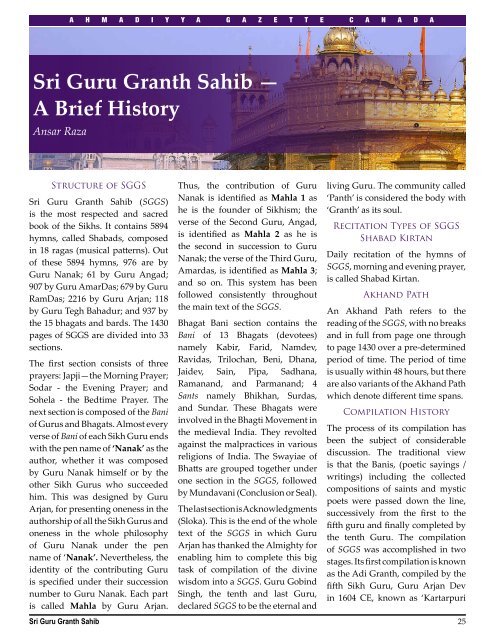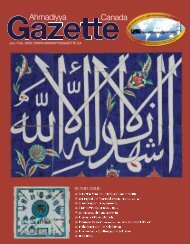English PDF - Ahmadiyya Gazette Canada
English PDF - Ahmadiyya Gazette Canada
English PDF - Ahmadiyya Gazette Canada
You also want an ePaper? Increase the reach of your titles
YUMPU automatically turns print PDFs into web optimized ePapers that Google loves.
Sri Guru Granth Sahib —<br />
A Brief History<br />
Ansar Raza<br />
Structure of SGGS<br />
Sri Guru Granth Sahib (SGGS)<br />
is the most respected and sacred<br />
book of the Sikhs. It contains 5894<br />
hymns, called Shabads, composed<br />
in 18 ragas (musical patterns). Out<br />
of these 5894 hymns, 976 are by<br />
Guru Nanak; 61 by Guru Angad;<br />
907 by Guru AmarDas; 679 by Guru<br />
RamDas; 2216 by Guru Arjan; 118<br />
by Guru Tegh Bahadur; and 937 by<br />
the 15 bhagats and bards. The 1430<br />
pages of SGGS are divided into 33<br />
sections.<br />
The first section consists of three<br />
prayers: Japji—the Morning Prayer;<br />
Sodar - the Evening Prayer; and<br />
Sohela - the Bedtime Prayer. The<br />
next section is composed of the Bani<br />
of Gurus and Bhagats. Almost every<br />
verse of Bani of each Sikh Guru ends<br />
with the pen name of ‘Nanak’ as the<br />
author, whether it was composed<br />
by Guru Nanak himself or by the<br />
other Sikh Gurus who succeeded<br />
him. This was designed by Guru<br />
Arjan, for presenting oneness in the<br />
authorship of all the Sikh Gurus and<br />
oneness in the whole philosophy<br />
of Guru Nanak under the pen<br />
name of ‘Nanak’. Nevertheless, the<br />
identity of the contributing Guru<br />
is specified under their succession<br />
number to Guru Nanak. Each part<br />
is called Mahla by Guru Arjan.<br />
Sri Guru Granth Sahib<br />
Thus, the contribution of Guru<br />
Nanak is identified as Mahla 1 as<br />
he is the founder of Sikhism; the<br />
verse of the Second Guru, Angad,<br />
is identified as Mahla 2 as he is<br />
the second in succession to Guru<br />
Nanak; the verse of the Third Guru,<br />
Amardas, is identified as Mahla 3;<br />
and so on. This system has been<br />
followed consistently throughout<br />
the main text of the SGGS.<br />
Bhagat Bani section contains the<br />
Bani of 13 Bhagats (devotees)<br />
namely Kabir, Farid, Namdev,<br />
Ravidas, Trilochan, Beni, Dhana,<br />
Jaidev, Sain, Pipa, Sadhana,<br />
Ramanand, and Parmanand; 4<br />
Sants namely Bhikhan, Surdas,<br />
and Sundar. These Bhagats were<br />
involved in the Bhagti Movement in<br />
the medieval India. They revolted<br />
against the malpractices in various<br />
religions of India. The Swayiae of<br />
Bhatts are grouped together under<br />
one section in the SGGS, followed<br />
by Mundavani (Conclusion or Seal).<br />
The last section is Acknowledgments<br />
(Sloka). This is the end of the whole<br />
text of the SGGS in which Guru<br />
Arjan has thanked the Almighty for<br />
enabling him to complete this big<br />
task of compilation of the divine<br />
wisdom into a SGGS. Guru Gobind<br />
Singh, the tenth and last Guru,<br />
declared SGGS to be the eternal and<br />
living Guru. The community called<br />
‘Panth’ is considered the body with<br />
‘Granth’ as its soul.<br />
Recitation Types of SGGS<br />
Shabad Kirtan<br />
Daily recitation of the hymns of<br />
SGGS, morning and evening prayer,<br />
is called Shabad Kirtan.<br />
Akhand Path<br />
An Akhand Path refers to the<br />
reading of the SGGS, with no breaks<br />
and in full from page one through<br />
to page 1430 over a pre-determined<br />
period of time. The period of time<br />
is usually within 48 hours, but there<br />
are also variants of the Akhand Path<br />
which denote different time spans.<br />
Compilation History<br />
The process of its compilation has<br />
been the subject of considerable<br />
discussion. The traditional view<br />
is that the Banis, (poetic sayings /<br />
writings) including the collected<br />
compositions of saints and mystic<br />
poets were passed down the line,<br />
successively from the first to the<br />
fifth guru and finally completed by<br />
the tenth Guru. The compilation<br />
of SGGS was accomplished in two<br />
stages. Its first compilation is known<br />
as the Adi Granth, compiled by the<br />
fifth Sikh Guru, Guru Arjan Dev<br />
in 1604 CE, known as ‘Kartarpuri<br />
25
















